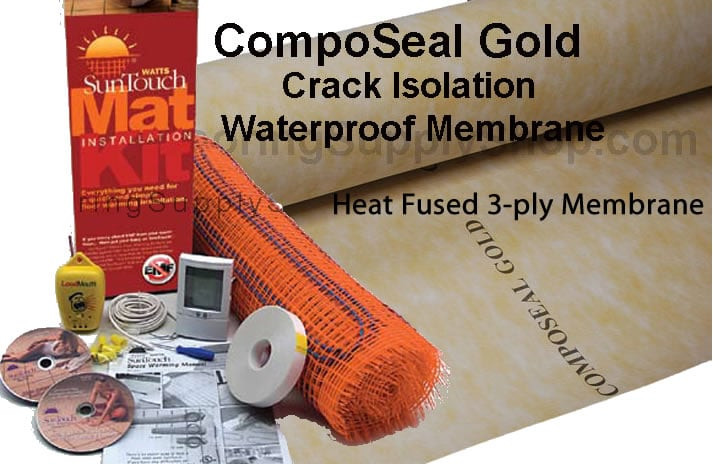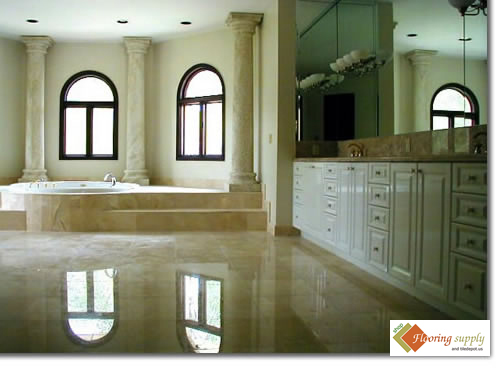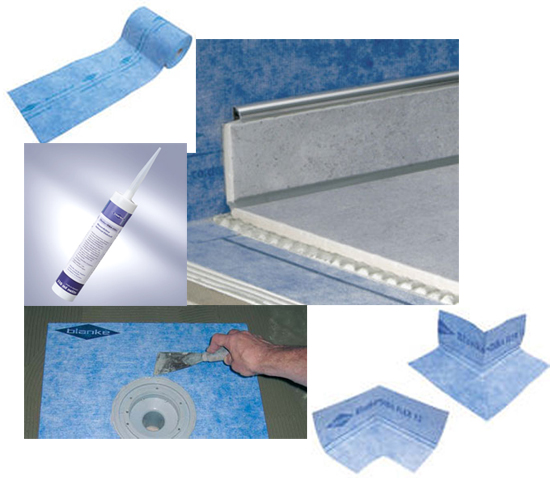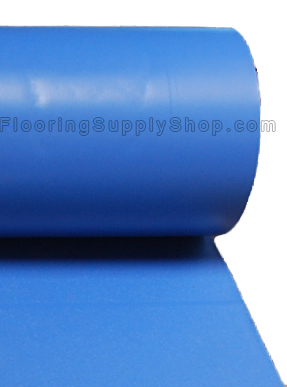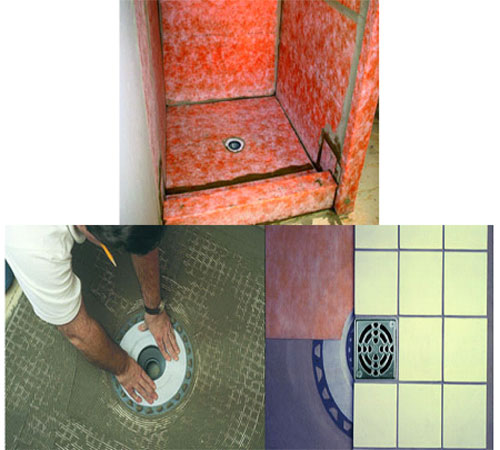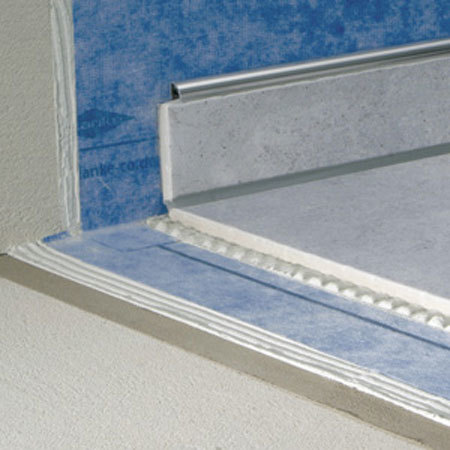Composeal Gold and Radiant Heat Flooring Systems.
Flexible Crack Isolation Waterproofing and Heat Fused for Floors – Walls – Roof Deck / Terraces – Under “thick bed” Tile Installations
Many of our customers have been asking us how Radiant Floor Heating Systems should be installed when using COMPOSEAL GOLD. When it comes to installing radiant floor heating, we go through a process called the “installation sandwich.”
As you go through the process of installing Radiant Floor Heating Systems, you can see that the flooring consists of a variety of layers. Like a sandwich, these layers stack on top of one another in order to function properly.
- Tile
- Latex modified thin set bond coat
- COMPOSEAL GOLD
- Latex Modified thin set bond coat
- Substrate or Subfloor with embedded Radiant Heating System
So what is COMPOSEAL GOLD?
COMPOSEAL GOLD is a direct bond membrane made up of a high-density PVC, with non-woven polyester scrim laminated on either side of the 40 mil sheet membrane, for direct bonding to the substrate as well as the ceramic tile or marble above. It does not rot and is highly resistant to solutions containing salts, acids, and alkalis, as well as many organic solvents, alcohols, and oils. COMPOSEAL GOLD is used as a concealed crack isolation (anti-fracture) and/or waterproof membrane under thin-set installations of ceramic tile and marble, terrazzo and brick; for new construction, remodeling or repair, residential and commercial, in kitchens, restaurants, resident entries, steam rooms, radiant heated flooring, shopping malls, etc.
Negligible shrinkage at extreme temperatures, -20° F to 212° F, makes COMPOSEAL GOLD especially ideal for Radiant Heated Flooring Systems. Its scrim is designed specifically for direct bonding on both sides of the “sandwich” in ceramic tile and dimension stone installations. This serves as a Crack-Isolation (uncoupling) membrane that provides adequate support/load distribution for your tile covering, and allows the heat from the system below to radiate up through the installation into the room.
*Always consult with the manufacturer of the radiant heating system for their specific installation instructions for installing radiant heating under ceramic tile.
Step 1: Expose the Subfloor
Remove the old carpet, leaving the subfloor exposed. If necessary, use a scraper to separate the carpet from the floor. Remove excess glue from the cement subfloor with scrapers and an appropriate solvent, making sure to follow the solvent directions.
Step 2: Apply a Crack-Suppression Membrane (COMPOSEAL GOLD)
Following the manufacturer’s instructions, apply adhesive to the concrete subfloor and lay down the crack-suppression membrane. Apply the adhesive in sections and unroll the membrane onto the floor, using a floor roller to press it flat and work out any air bubbles. Since concrete expands and contracts as the temperature changes, this membrane will help support the floor and prevent cracks in the tiles or grout.
Step 3: Install the Grids for the Radiant Heating System
Install the plastic grids that will hold the radiant-heat wires, using hot glue to adhere the grids to the subfloor. Follow the manufacturer’s instructions, and space the grids uniformly over the floor to prevent hot and cool patches.
Step 4: Snap the Cables into the Grids
Snap the radiant-heat cables into the grids, keeping them evenly spaced to prevent hot and cool patches in the floor. Check the manufacturer’s instructions for guidance on how far apart to space the cables.
Step 5: Mix and Spread the Thinset Mortar
Use a heavy-duty drill with a paddle bit to mix Thinset mortar according to the package instructions. Use a straight-edge trowel to apply a layer of mortar over the electrical cables. When mixed to the correct consistency, the mortar will stick and mound on the trowel without falling off. Make sure to hold the trowel at a consistent angle throughout the job so the mortar bed will have a uniform thickness. Allow the mortar to dry thoroughly before proceeding. Wet or cold weather will slow down the drying process, and below-freezing temperatures can keep the mortar from curing properly. Consult the manufacturer’s instructions for guidance.
Step 6: Power the Radiant-Heat Floor
The best way to power the radiant-heat floor is to hire a licensed electrician to run a dedicated circuit from the home’s main electrical panel to the correct room. The electrician also can install the control panel/heating sensor in the wall.
Step 7: Determine the Layout
Dry-fit a vertical row of tiles and a horizontal row, leaving space for grout, to determine the best layout. The ideal layout will use as many full tiles as possible. The tiles against the wall should be a half-tile wide or wider.
Step 8: Spread Mortar and Lay the Tiles
Spread mortar on the floor, using the notched edge of the trowel to create deep grooves in the mortar. Press each tile into the mortar, wiggling it gently to seat it. Check the tiles for level and adjust as needed. Use tile spacers to keep an even grout line. Use a wet saw to cut tiles as needed for the perimeter of the floor.
Safety Alert: Always wear safety glasses and use caution when working with a wet saw.
Step 9: Mix and Apply the Grout, and Apply Sealant
After the mortar is dry, mix the tile grout according to the package instructions and apply with a grout float. Use a diagonal motion to apply the grout, working it into the spaces between the tiles. Let the grout dry slightly, then wipe the excess off the tiles with a damp sponge using a diagonal motion.
Let the grout dry completely before sealing. Once the grout sealant is dry, move the furniture back into the room. Let the mortar cure for four weeks before using the radiant-heat system.
CODES, CERTIFICATION
COMPOSEAL 30 and 40 comply with the three major plumbing codes: UPC-IAPMO, SBCCI and BOCA. COMPOSEAL has separate municipal approval where required, e.g. City of Los Angeles, City of Philadelphia (40 mil), Metropolitan Dade County and Commonwealth of Massachusetts. (Approval is no longer required in New York City for concealed PVC waterproof membrane).
COMPOSEAL also complies with the Corps of Engineers specs for PVC shower pan material (para 5.8.3.2 15 p1-18) and meets the requirements of FHA Publication 4900.1.
WARRANTY: COMPOSEAL 30 and 40 are warranted against failure for any reason, and in the event of failure, replacement material will be supplied at no charge. This warranty applies only to the membrane itself and not to the manner of installation over which we have no control, and it does not extend to consequential damage or other implied responsibility. COMPOSEAL should last the life of the building.
Made in USA – 100% American Labor and Materials.
